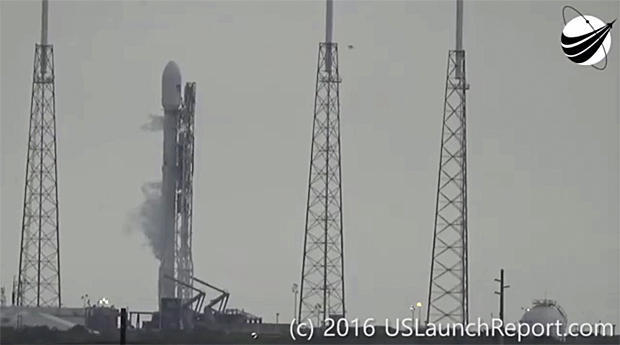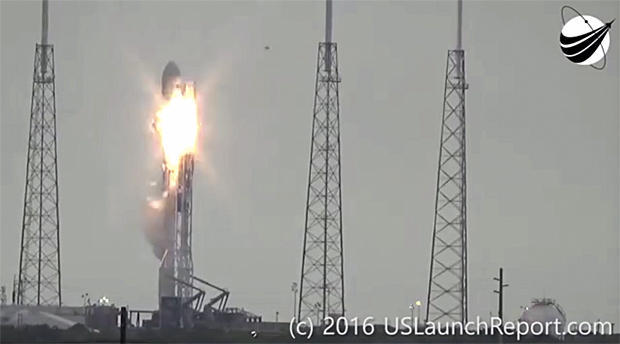Elon Musk: SpaceX rocket explosion probe "most difficult and complex" ever
The launch pad explosion that destroyed a SpaceX Falcon 9 rocket and its satellite payload during a routine pre-flight test is proving to be the “most difficult and complex” failure the company has ever encountered, Elon Musk, SpaceX founder and chief designer, said in a series of tweets Friday.
In the company’s first comment since last Friday -- the day after the explosion at the Cape Canaveral Air Force Station -- Musk said the disaster is particularly baffling because it occurred during fueling for a launch pad engine test firing, a routine pre-launch milestone for Falcon 9 rockets.
“Still working on the Falcon fireball investigation,” he tweeted. “Turning out to be the most difficult and complex failure we have ever had in 14 years.”
He went on to say it is “important to note that this happened during a routine fueling operation. Engines were not on and there was no apparent heat source.”
Thanking NASA and the Air Force for their “support & advice,” Musk added a cryptic comment: “Particularly trying to understand the quieter bang sound a few seconds before the fireball goes off. May come from rocket or something else.”
Video of the explosion shot by USLaunchReport includes two brief “bang sounds” about five seconds before the rocket exploded, the first louder than the second. The explosion originated at or near the rocket’s second stage.
But the camera that shot the video is believed to have been about 2.5 miles from the pad, and it’s possible the sound Musk referred to was something different.
A Twitter follower asked Musk about unverified claims on the internet that “something hit the rocket. Any reality there?”
Musk replied: “We have not ruled that out.”
Yet another Twitter follower told Musk the sound he referred to sounded “like a metal joint popping under stress. e.g. weld failing on strut, welded seam bursting, etc.”
Musk replied: “Most likely true, but we can’t yet find it on any vehicle sensors.”
SpaceX was preparing the $62 million Falcon 9 rocket, carrying a $195 million Israeli communications satellite, for launch Aug. 3. The rocket was loaded with liquid oxygen and refined kerosene fuel on Aug. 1 for a short test firing of the nine Merlin 1D engines powering the booster’s first stage.
The “static hot-fire test” is a routine part of SpaceX’s Falcon 9 launch preparations, designed to catch any propulsion, command or control problems and to verify the booster is ready for flight.
In the 28 previous Falcon 9 launch campaigns dating back to 2010, problems were occasionally identified, but the test itself was never an issue. That was not the case on Aug. 1.
At 9:07 a.m. EDT (GMT-4), eight minutes before the first-stage engines were to fire, the rocket suddenly exploded in a spectacular shower of flaming debris and fast-burning propellants, generating ground-shaking shocks, a huge series of fireballs and a towering column of black smoke.
The explosion presumably caused severe damage to launch complex 41, a former Air Force Titan launch pad that is leased by SpaceX, but so far the company has released no details on the extent of the damage, what might be required to repair it and, consequently, how long it might take to return the pad to launch-ready status.
A source said Thursday residual contamination, presumably from propellants, had prevented quick access to the pad for detailed inspections.
In the meantime, SpaceX flights are on hold and customers face what could be lengthy delays getting their payloads into space depending on whether the failure was triggered by a fault in the rocket, ground systems or some external factor.
In SpaceX’s only previous Falcon 9 failure, a space station-bound cargo ship was destroyed during launch June 28, 2015, when a helium pressurization tank inside the second stage liquid oxygen tank broke free when an internal strut failed, triggering the booster’s aerodynamic breakup while the first-stage engines were still firing. It took SpaceX nearly six months to recover from that setback.
A retired shuttle pad at the Kennedy Space Center that has been leased by SpaceX should be ready to support launches later this year. But the company’s busy manifest would seem to require two East Coast launch pads to meet its schedule.
SpaceX operates a third pad at Vandenberg Air Force Base, Calif., for payloads that require polar orbits, and is building another complex in Texas for commercial launchings.
The satellite telephone company Iridium plans to launch 70 next-generation satellites aboard seven Falcon 9 rockets before the end of 2017. The first 10 relay stations were scheduled for launch Sept. 20 from Vandenberg, but that flight and other downstream missions are on hold.
Even so, Space News reported Friday that Thomas Fitzpatrick, Iridium’s chief financial officer, told a Paris investors conference Thursday that SpaceX had revolutionized the launch industry and that “our confidence in them is not shaken. We’re sure they are going to figure out what happened and get back in business.”
In two tweets in the wake of the Aug. 1 explosion, Musk said the conflagration appeared to originate “around upper stage oxygen tank. Cause still unknown. More soon.” He later responded to a query from a Twitter follower he described the incident as “really a fast fire, not an explosion.
Late Aug. 2, the company posted an update saying engineers were evaluating 3,000 channels of telemetry during a period between 35 and 55 milliseconds. But no additional details have been provided about what the data might reveal.
SpaceX asked any members of the public who may have audio, photos or videos of the incident to share them with the company at: report@spacex.com. “Material may be useful for investigation,” SpaceX tweeted.


